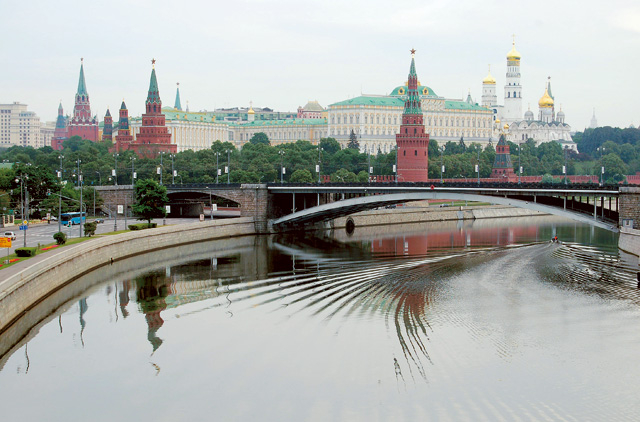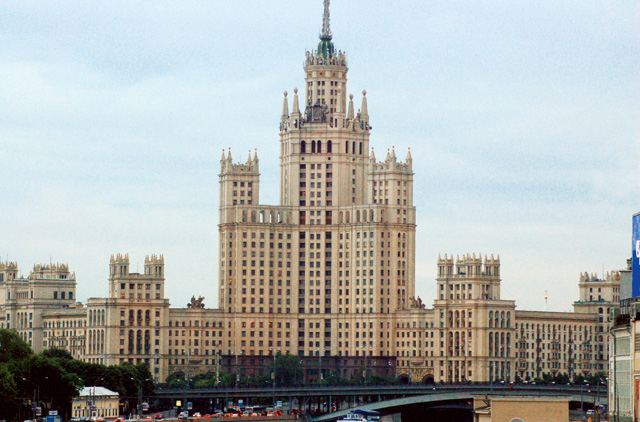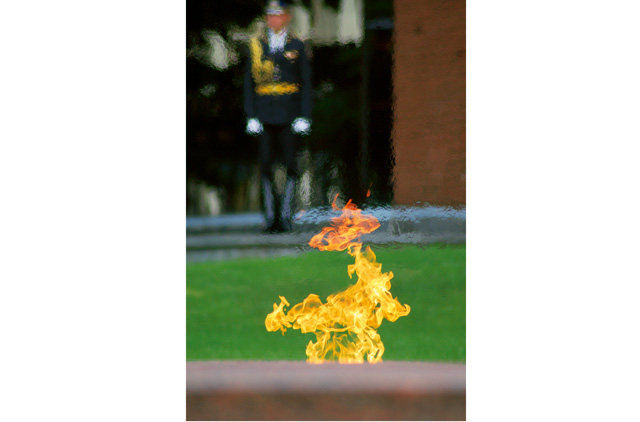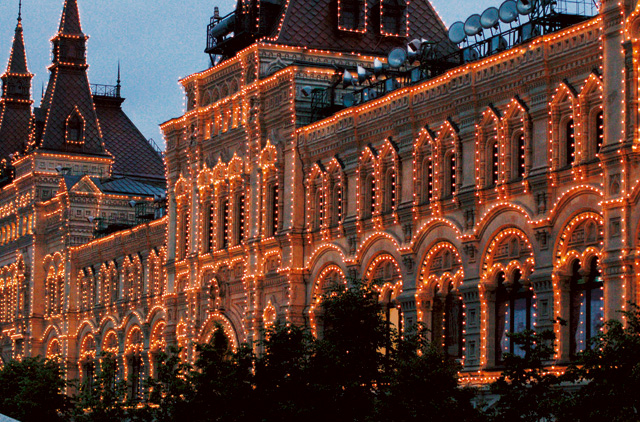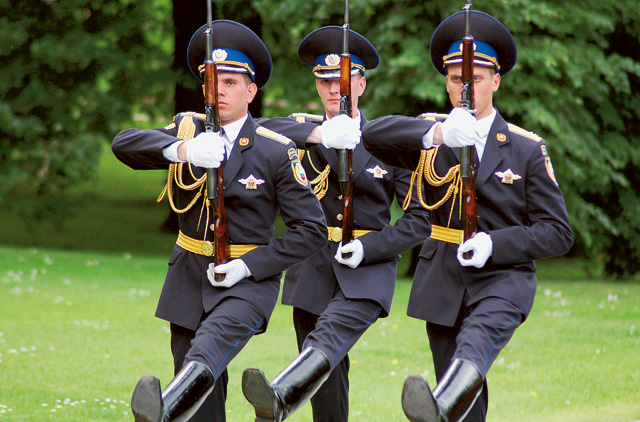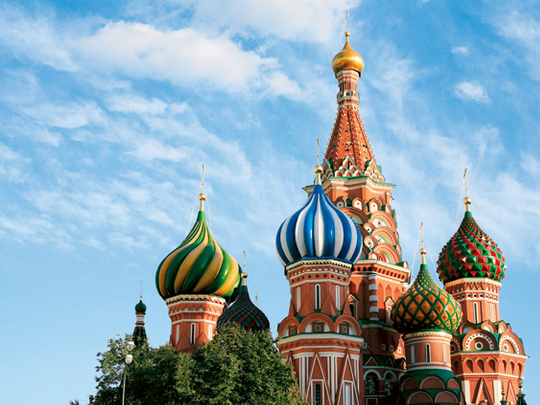
Nothing prepares travellers for the unique sight of St Basil's Cathedral. It stands at the foot of the Red Square in Moscow looking like something from a book. The giant Russian Orthodox Church, which was built during the 16th century, is otherwordly. St Basil's is unlike any other building in the world. The cathedral was designed to look like a bonfire flame rising into the sky and remarkably, it does. Its towers are like upside-down ice cream cones from a psychedelic party for giants and its spires look as though they've been dipped in swimming pools full of coloured paint. In the 16th and 17th centuries, it was a symbol of the unique Byzantine architecture but more recently, it has served as a symbol of one of the world's most enigmatic cities: Moscow.
As I stood at the foot of the steps leading into St Basil's a choir was singing ecclesiastical music that drifted onto the street. It was an intoxicating experience. I bought a ticket from a vendor in a small booth and entered the building.
It was a warren of rooms and corridors - deserving of the critique by an author on Russian architecture, William Brumfield, who wrote, "it is a structure devoid of restraint or reason". Normally, I travel at short notice, preferring to book and fly when the mood takes me. Trips rarely take more than a few days or weeks to plan. Moscow, however, was different. I planned it well in advance, spending months reading, making sure I was familiar with local traditions and customs. I considered it a personal rubicon: a place that this non-Russian speaking, non-Russian reading traveller had to visit to prove his mettle. The British leader Sir Winston Churchill famously described Russia as being: "A riddle wrapped in a mystery inside an enigma." Moscow was at the very centre of that conundrum. And yet...
East meets West
Modern-day Moscow bears little resemblance to the city that has captivated and mystified travellers for thousands of years. Today, it is cutting edge; a glitzy tinseltown where East and West collide. Near Red Square there were people dressed as Lenin and Marx. They posed for photographs, saluted visitors and shook the hands of locals.
But there is an influx of the new: there was a BMX stunt exhibition in Red Square as well as a football match, bringing youth to life in the city. Twenty-first century Moscow provides heady retail thrills that try to rival Dubai; cultural encounters more marvellous than those in Paris or Rome; a hustle and bustle to match Istanbul and more. Moscow is like all the world's great cities wrapped up in one. There is something for everybody.
I was staying at the Ararat Park Hyatt Moscow, just off Red Square and a short walk from the Kremlin, and St Basil's. Nearby were attractions, including Parliament Square and the luxury department stores Tsum and Gum. Recognised as one of the Best Bars in the World by Architectural Digest, the Conservatory Lounge and Bar located in the hotel, offered panoramic views of the city and was ultra-modern. Its restaurants were similarly impressive. The breakfast made for a wonderful start to the day. My favourite was Russian syrniki - sweet cottage-cheese fritters - with raisins, sour cream and dripping with honey.
A bit of culture and commerce
I had four days in Moscow and wanted to see as much as possible. I'd planned to mix culture and commerce, by visiting some of the city's premier stores and a number of cultural attractions. Churches, Red Square, Tolstoy's House and Lenin's Mausoleum were on my cultural hit list, while my must-visit shops included Gum and Tsum. Tsum is one of the most fashionable places in the city. A fusion restaurant and cigar room were among my favourite parts of the store. There are more than 1,000 clothing brands available. The world's greatest designers and most famous models regularly frequent the frighteningly expensive department store. Tsum is actually Moscow's first department store and was even frequented by Anton Chekhov.
Gum was even fancier and while I was there, I stocked up on some delicious deli treats. It is part of an arcade that features other glittering stores selling high-end products. The store is separated into lower and upper trading rows, and features exquisite steel framework and a glass roof. Visitors on a budget ought not to miss it even if you're not in the market for luxury goods! It's worth a visit even if you're just there to marvel at the architecture. Gum faces the storied Red Square, and the Kremlin and Lenin's Mausoleum dominate its outer flank.
Red Square has a fascinating history. It was paved in stone at the start of the 19th century, with major improvements taking place following the Napoleonic invasion. More recently, it has been the site of great military parades and concerts for artists as diverse as Paul McCartney and Red Hot Chili Peppers.
There was a long queue to enter Lenin's Mausoleum, which contained the preserved, waxy-looking body of the nation's father Vladimir Lenin. Visitors, many of them Russian, passed through in eerie silence, paying respects to the leader.
Gorgeous green space
After leaving the Red Square. I followed the Moskva River to Alexander Garden, a beautiful public garden. Couples cuddled on benches, elderly residents discussed the way things used to be and tourists marvelled at the beauty around.
The Tomb of the Unknown Soldier was located at the end of the garden at the Kremlin Wall. Soldiers protected the monument, which was opened in 1967 to honour those who fell in 1941 during The Battle of Moscow. An eternal flame was lit before a tomb marked with the words: "Your name is unknown, your deed is immortal."
I returned to the river to wander along the banks of the Moskva until I reached Cathedral of Christ the Saviour, a vast white and gold structure located on the far side of Moscow's Great Stone Bridge. The church, which is the tallest Orthodox church in the world, was magnificent. It has monumental artwork lining the walls and ceilings, and was rebuilt after being blown during Stalin's rule.
There was one final destination on my list: the house of great Russian Leo Tolstoy, who wrote War and Peace, Anna Karenina and numerous other great works. The house was located on Arbat Street, and I decided to walk through the city to get there.
Once I arrived I saw an impressive two-storey wooden building where Tolstoy lived during the winter from 1882 until his death in 1910. I got a sense of what it must have been like for Tolstoy to entertain Moscow's cultural elite. It was a treasure from the past, evocative of a bygone era. I felt a sense of privilege as I walked through rooms that bore witness to the birth of great literature.
Moscow is a beguiling city. There are many reasons why visitors might be put off - it can be cold and the language and alphabet are not easy to learn. Luckily communication was not difficult and Muscovites were extremely helpful. The city has treasures the likes of which cannot be found anywhere else in the world.


